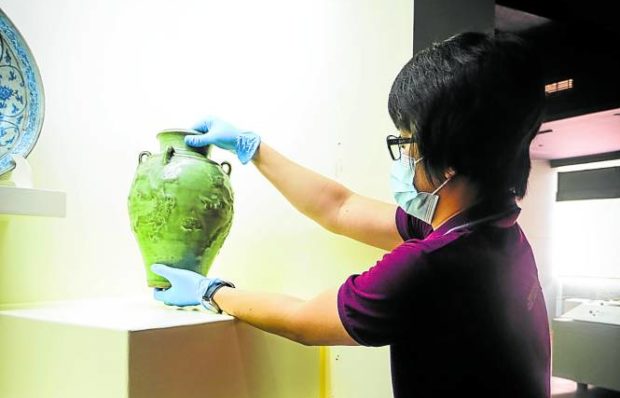Rare celadon jar comes home to Marinduque

HOMEWARD BOUND | Gregg Alfonso Abbang, a researcher at the Archeological Division of the National Museum of the Philippines, takes the celadon jar from its display case to be returned to Marinduque on Feb. 21. The jar, discovered in Marinduque sometime in the early 1960s, has been stored in the National Museum since 1965. —PHOTO FROM THE NATIONAL MUSEUM OF THE PHILIPPINES FACEBOOK PAGE
BOAC, Marinduque, Philippines — One of the only three known celadon jars of its kind in the world has finally returned to Marinduque after over half a century since it was discovered in this island province.
The celadon jar was unveiled at the satellite display center of the National Museum of the Philippines in this town on Feb. 21 as part of the celebrations for the 102nd founding anniversary of Marinduque.
Personnel from the National Museum Marinduque, Romblon satellite office, other local government officials, and representatives from the academe witnessed the unveiling of the Marinduque celadon jar.
Local officials and residents led by Gov. Presbitero Velasco Jr. said they were grateful to everyone who exerted effort in getting the celadon jar back to Marinduque where it was found sometime in the early 1960s.
“Such tangible cultural heritage is a vital part of our identity and they are our windows to the past,” said Velasco during the unveiling.
Article continues after this advertisementVelasco’s son, House Speaker Lord Allan Jay Velasco, said that the discovery of the celadon jar in Marinduque was “a proof of the rich and noble/dignified culture and history” of their ancestors.
Article continues after this advertisement“It signifies that people of Marinduque were already civilized even as early as the 15th century or even before the Spanish conquerors came here. This was also a symbol of the businesses with the Chinese,” he said in a message read by Provincial Administrator Michael Velasco.
Unique find
There are only two other known celadon jars of this kind, according to the National Museum.
One is displayed at the British Museum in London in the United Kingdom.
The other was owned by the late art collector Arturo de Santos, a Filipino ceramic enthusiast in the 1960s. Records were scarce as to the exact whereabouts of most of the De Santos art collection, including the celadon jar after he died in 1996.
The Marinduque celadon jar was declared in 2010 as a National Cultural Treasure by the National Museum for its rarity, craftsmanship, and historical and cultural relevance.
The National Museum described the jar as “rare stoneware dated to 1279 to 1368 Common Era (CE), during the Yuan dynasty in China. It features a translucent jade-like green glaze application throughout its body, decorated with four Chinese dragons in embossed relief—a symbol of imperial power, strength and good fortune in East Asian culture.”
The 31.2-centimeter-tall and 18.5-cm-wide jar has an everted rim, a short-waisted neck edged shoulder with four vertical lugs, a broad body, narrow bottom and flat foot.
Celadon, or greenware, is a kind of stoneware ceramic with bluish-green or grey-green glaze fired between 1,200 degrees Celsius and 1,350 C.
“Its dragon motif suggests that the Marinduque celadon jar is not an average object but a unique marker of prestige, making it an important and rare acquisition of the National Museum,” the museum said.
Mysterious owner
The jar came into the possession of the National Museum in 1965 when it was purchased by the museum’s then assistant director, Alfredo Evangelista, who included the artifact in the museum’s collections.
But who actually owned the jar before it was bought by Evangelista, or from whom did he acquire the artifact, remained a mystery.
According to National Museum records, all they knew was that Evangelista conducted a systematic excavation at Pilapil Cave (now Ka Amon Cave) in Torrijos, Marinduque, in 1961, which yielded local artifacts and sherds, or pieces of ceramic wares, associated with Song (960-1279 CE) and Yuan (1279-1368 CE) periods. But it was not clear if the celadon jar was among them.
Evangelista, who died in Laguna province on Oct. 18, 2008, did not leave any record on how he came to own the celadon jar.
Local historians and researchers, to this day, are still investigating the jar’s past whereabouts before it came into Evangelista’s possession.
RELATED STORY